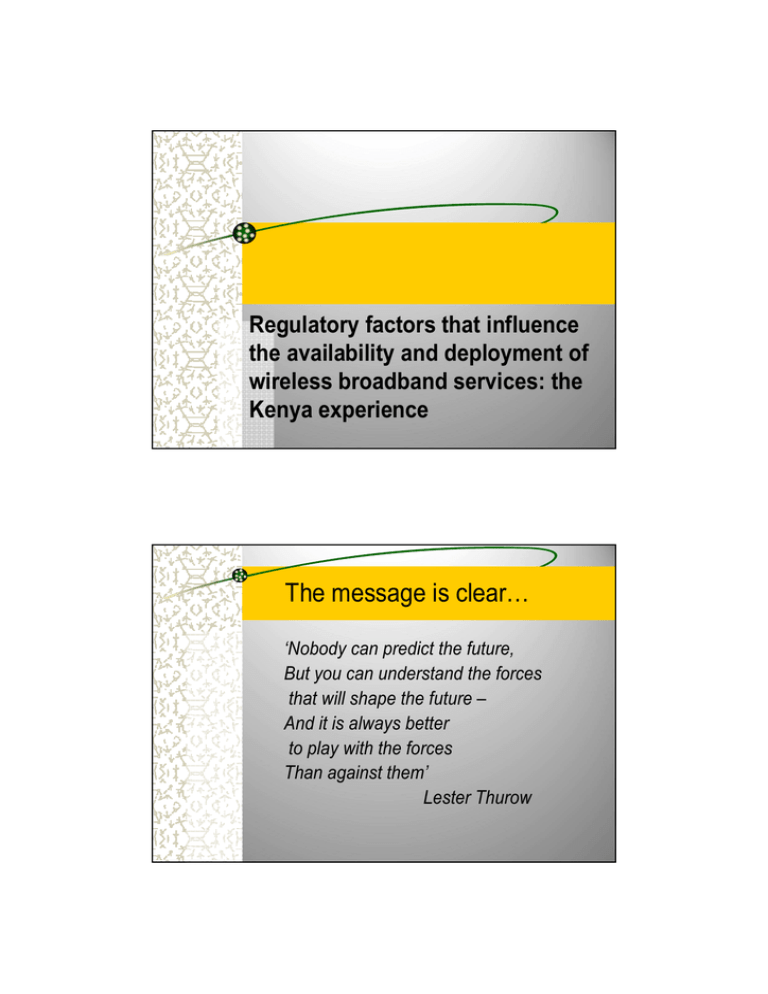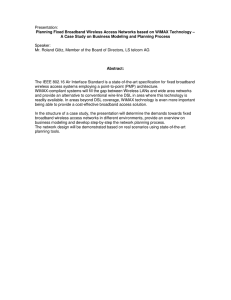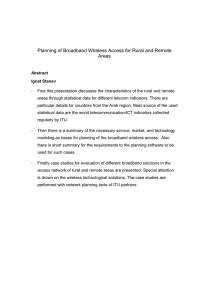Regulatory factors that influence the availability and deployment of Kenya experience
advertisement

Regulatory factors that influence the availability and deployment of wireless broadband services: the Kenya experience The message is clear… ‘Nobody can predict the future, But you can understand the forces that will shape the future – And it is always better to play with the forces Than against them’ Lester Thurow Africa – on the cutting edge of technology A “wireless continent” characterised by: – – – – Pan-African mobile operators Mobile lines surpass fixed line connections Relatively new regulatory frameworks Pre-paid services What drives convergence? Wireless access technologies High penetration of mobile telephony Opportunities for reduced CAPEX through network level integration Comparative Fixed mobile pricing New technologies such as Internet and VoIP to give subscribers one number, one handset, always on. Evidence of response to convergence in the market Cross-product and cross-platform development Cross-sector shareholding Change of consumer behaviour Mergers and Acquisitions Lowering of barriers to entry Cross-jurisdictional operations Heavier branding by operators The unfolding realities… The ubiquitous wire line network may never arrive …… Access networks are likely to be mobile and wireless Broadband wireless technologies will have to dovetail with the prevalent mobile presence A combination of network types will have to be deployed for transport and backhaul Potential for innovation and creativity, market growth and transformation Global broadband subscription How is a regulator to react? Need to re-assess the role of regulation Need to get over the traditional mono-media regulation hangover Need to be proactive and responsive At the basic minimum…. Regulation should be guided by a clear and predictable framework Regulation needs to meet a range of public interest objectives whilst recognising the need to promote investment particularly in new services Regulation should facilitate full participation by citizens in the information society Regulation should be limited to what is strictly necessary to achieve clearly identifiable goals The case in Kenya Government owned and controlled prior to 1999 – Kenya Post & Telecommunications Corporation Kenya Communications Act of 1998 – Sector-specific legislation – Liberalization and creation of a regulator Sector Policy Statement : May 2006 – Embraces convergence outcomes such as deployment of broadband wireless applications Outcomes of Sector Reform Liberalization and privatization of the sector to: – Encourage private sector investment – Improve economic accessibility to services – Improve quality in service delivery P ER I OD Total Fixed LineSubscribers Total Mobile Subscribers Dec. 04 Jun-04 Feb.2004 Dec-03 Jun-03 Jun-02 Jun-01 Jun-00 3,750,000 3,500,000 3,250,000 3,000,000 2,750,000 2,500,000 2,250,000 2,000,000 1,750,000 1,500,000 1,250,000 1,000,000 750,000 500,000 250,000 0 Jun-99 SUBSCRIBERS Outcomes Sector Reform: FixedMobile Comparison Analysis outcomes The unmet market demand for telephony in Kenya is between 4.7 and 9.4 million Expected economic growth will enhance both qualitative and quantitative demand Wireless technologies are poised to meet this demand Need to re-assess the regulatory framework Kenya’s reaction Views convergence as an opportunity Willingness to understand it Need for leverage broadband wireless access technologies to meet universal service goals. The future shape of Regulation Optimise opportunities offered by convergence Need for an appropriate regulatory environment to complement trend of convergence Update outdated regulatory frameworks and reduce regulatory burdens Technological neutrality Focus on competition safeguards and consumer protection Cont. Enlighten communities on broadband provisioning opportunities to drive demand Embrace stakeholder consultation more to optimise broadband opportunities Commit to capacity building of regulatory staff to leverage opportunities offered by convergence Secure public interest objectives Obtain appropriate design for universal service provision – Should scope of USO be widened to accommodate BWA ? Seek regulatory harmony for cross-jurisdictional operations and regional markets Deal with regulatory barriers Deal with regulatory barriers Market entry: stable and predictable Access to networks and content Standards interoperability Licensing Allocation of resources e.g. Frequencies Greater focus on consumer interests CONCLUSION Broadband wireless access technologies are going to provide broadband capabilities into the future especially in the context of developing markets. Plan for this reality at the regulatory level for an optimal outcome. Thank you ☺ Mercy Wanjau Principal Legal Officer Communications Commission of Kenya wanjau@cck.go.ke


